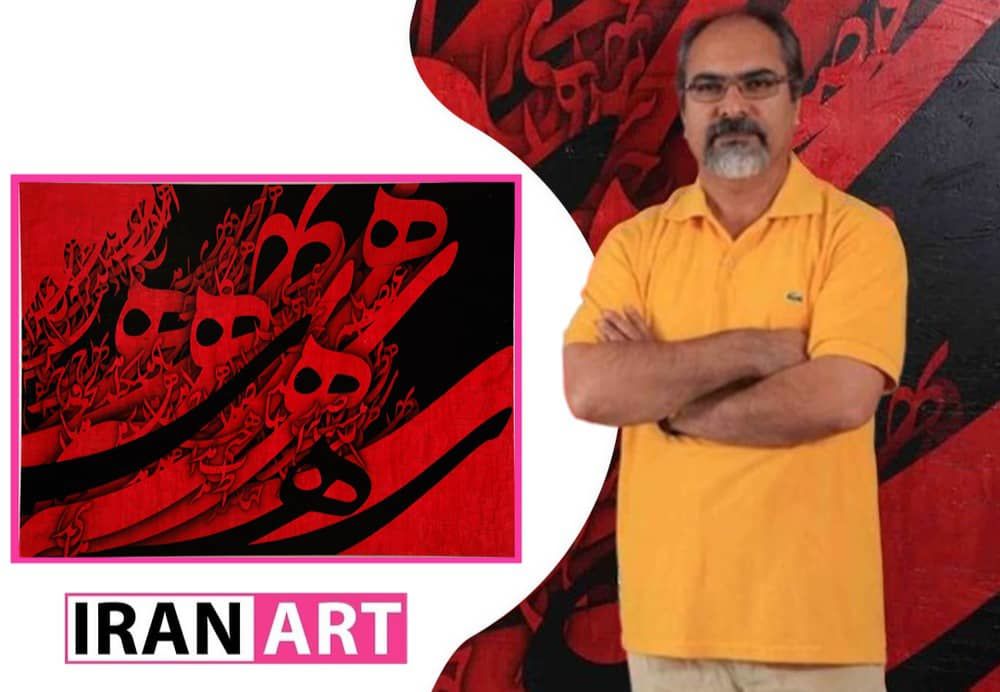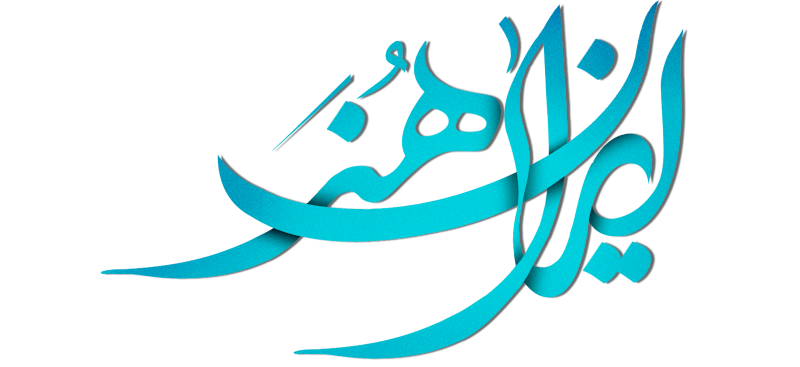Ali Shirazi | Ali Shirazi Calligraphy | Siyah mashq
Ali Shirazi and the Mysteries of Siyah mashq in Calligram

A surreal painting-like piece, Ali Shirazi's red painting with Siyah mashq" features intriguing and striking calligraphic moments of words and characters.
IranArt : An artwork by Ali Shirazi , a well-known calligrapher and calligram artist in the Middle East, is examined and analyzed in this article.
Siyah mashq, which translates to "Black practice," fills this crimson painting. It also features some intriguing calligraphic word and letter moments that are perfect for surrealist art.
In addition to his classical calligraphy, Shirazi is recognized in the Middle East art market for this particular style of work, which was on display at the Dubai RIRA Gallery in the DIFC from April to May 2013 and eventually sold.
1:
The first thing you notice when you come across this enormous 250 by 180 piece with that striking color is 12 eyes shaped like the letter "ه" ("H") as if they are staring at you. Two elongated bodies of the black letter "س" ("S") occur in addition to these six exquisite and elongated "ه" ("H") , which strengthens the composition of the work.

But right once, your eyes are drawn to a deluge of intricately gorgeous, gracefully forming characters and phrases. They appear to be marching over the stage, having emerged from the shadows. These are examples of Siyah mashq.
2:
Nobody knows who invented Siyah mashq, one of the most striking aspects of Persian Nastaliq calligraphy. Perhaps it formed accidentally. All calligraphers warm up their hands and begin writing calligraphy by doing Siyah mashq, the most liberated type of Nastaliq.
Siyah mashq consist of a few key elements: Naturally, there are ten alternative methods to write each word in Nastaliq. The extremely fine details that set calligraphers apart include the letter and word forms they select based on the most attractive visual feature of each, how well they match their selection with the words that come before and after, and of course how the final composition looks. Renowned calligraphers have created strokes that appear to flirt with words and letters by taking advantage of Siyah mashq's flexibility.
From this vantage position, Master Shirazi's Siyah mashq are well-known across the world, and Middle Eastern collectors and foreign auction houses both appreciate this body of work.
In an interview from a few years ago, Shirazi stated: "I have always loved writing Siyah mashq nonstop. I have written hundreds and hundreds of them, which have been displayed in publications and exhibitions. I have lived with traditional Siyah mashq for years. I also wanted to have a new experience with Siyah mashq by going into the field of calligram, which would speak new words, show the public a novel form, and adhere to the core values of traditional calligraphy. I found it really difficult to balance these two ideas—classic and modern."
3:
It is believed that in calligram, painting activity takes precedence, and that every calligraphic dimension, including line, should function as an element of the image. All of these requirements are quite visible in Shirazi's work.
4:
One of the most significant aspects of this Shirazi artwork is the exquisite hue and harmony of red and black.
He simply used these two colors to construct the work. The audience is free to interpret whether this piece represents a progression of darkness or a crimson celebration and joy based on their current emotions or life experiences.
The artist's innovative technique of delicately blackening the inner parts of the five "ه" ("H") eyes has positively impacted the piece's color harmony.
However, black has always been a color that Shirazi has used to emphasize his visual universe. Like many others, he believes that "Black is Beautiful" and has made excellent use of the modest yet everlasting color.
5:
Fluent speakers of Arabic or Persian might be able to decipher some of the words and letters in these Siyah mashq, but there is undoubtedly not much information about the phrases and their meanings because the letters' shadows create an abstract or surreal appearance.

6:
The demand for Shirazi's calligraphies in the Middle Eastern art market is rising. The Iranian artist has achieved remarkable prices for highly sought-after pieces at Bonhams London and other auction houses, aside from his record Christie's auction result of $60,000 in 2012. Examples of his previous sales may be seen on reliable websites like Art Price.
Numerous of the most valuable collections in the Middle East feature pieces from Master Shirazi, such as the collections of the eminent Arab poet and writer Mohammad Al Murr in the United Arab Emirates; the Al Owais Institute in Dubai; the Anwar Gargash collection in Dubai; the Juma Al Majid collection in Dubai; the museums in Sharjah, Doha, and Qatar; the most important private collectors, including Pasargad Bank of Iran; and religious collections in Iran, such as the Quran Museum and Imam Ali Religious Arts Museum in Tehran.

